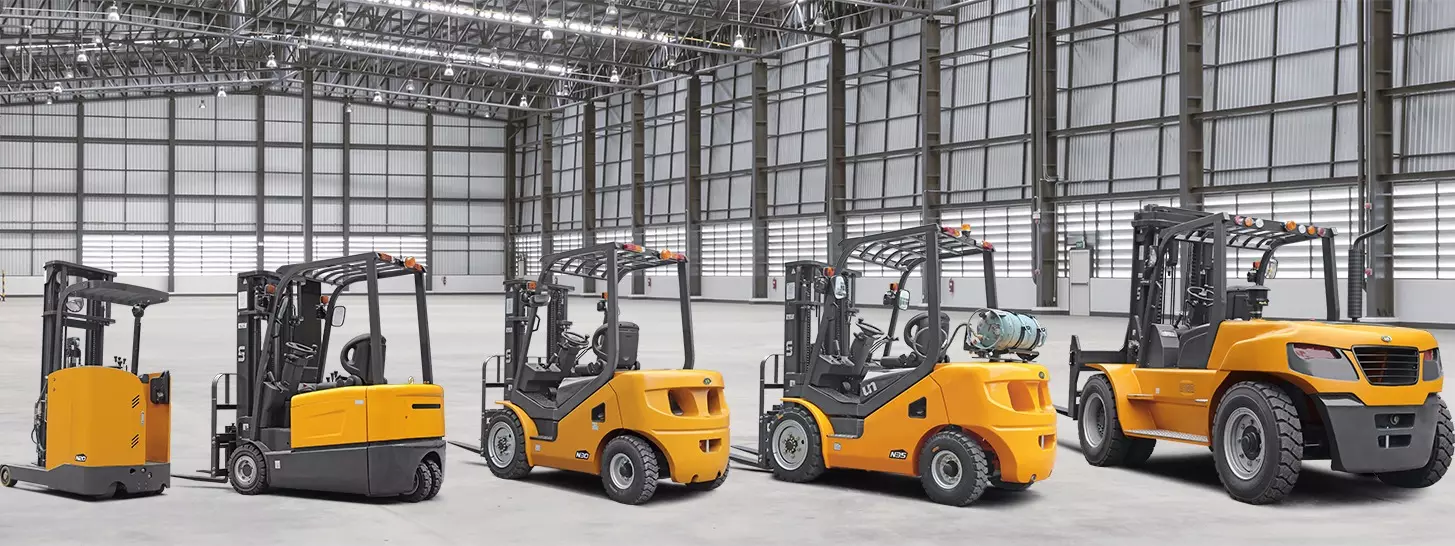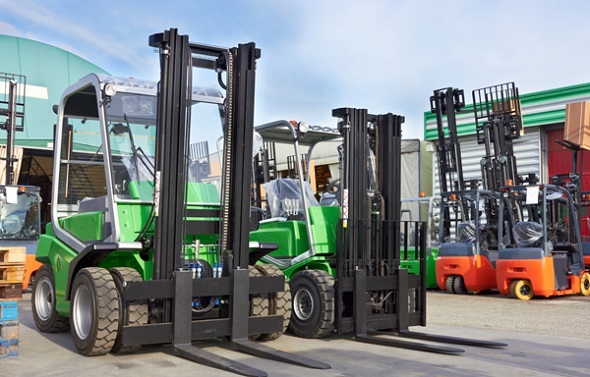We all call them different forklift names. People tend to refer forklifts as many different things such as a forklift truck, lift truck, fork truck, forklift. But it’s basically a powered industrial truck which is used to lift and transport materials in businesses. Most commonly goods that are stacked on pallets.
Forklifts can actually be traced back to the late 1800’s. The modern forklift was developed in the 1960s by various companies including the transmission manufacturing company Clark and the hoist company Yale & Towne Manufacturing.
The forklift has since become an indispensable piece of equipment in manufacturing and warehousing operations.
Different forklift names
Lets take a look at the more common forklift types.
Manual pallet truck
It has no power system of any kind – Click here to read about Manual Pallet Jacks adding value to your business.
Walkie low lift truck
Basically what is referred to as a powered pallet truck, usually electrically powered.
Rider low lift truck
Usually electrically powered.
Towing tractor
Tow Tractors are generally an internal combustion engine or electric powered
Walkie stacker
Pedestrian operated usually electrically powered
Rider stacker
Usually electrically powered
Reach truck
This one is a variant on a Rider Stacker forklift. Designed for small aisles, usually electrically powered, named because the forks can extend to reach the load. There are two variants, moving carriage, which are common in North America. And the moving mast which are common in the rest of the world, and generally regarded as safer.
Electric counterbalanced truck
Comes in a couple of different versions. Stand on End Control, Stand on Center Control, and Sit Down Center Control, which is by far the most common
Internal Combustion Engine Powered Counterbalanced Forklift
Comes in Stand on End Control, Stand on Center Control, and Sit Down Center Control, which is the the bread and butter of the industry. Engines come in, kerosene, gasoline, natural gas, butane, or propane fuelled, and may be either Two Stroke Spark Ignition, Four Stroke Spark Ignition (common), Two Stroke Compression Ignition, and Four Stroke Compression Ignition (common).
North American Engines generally come with advanced emission control systems. Forklifts built in countries like Iran or Russia will typically have no emission control systems.
Electric Forklifts
Are powered by lead-acid batteries and now lithium-ION batteries. Several types of forklifts are electric: cushion tire forklifts, scissor lifts, order pickers, stackers, reach trucks and pallet jacks. Electric forklifts are primarily used indoors on flat, even surfaces.
Electric forklift batteries in Australia generally rated to last 5 consecutive hours or throughout an 8-hour shift with 2-3 breaks. Batteries prevent the emission of harmful fumes and are recommended for facilities in food-processing and healthcare sectors.

Sideloader
Comes in Stand on End Control, and Sit Down End Control, which is the most common. It may be Electrically Powered, or have an Internal Combustion Engine. Engines may be diesel, kerosene, gasoline, natural gas, butane, or propane fueled, and may be either Two Stroke Spark Ignition, Four Stroke Spark Ignition (common), Two Stroke Compression Ignition, and Four Stroke Compression Ignition (common).
North American Engines come with advanced emission control systems. Forklifts built in countries like Iran or Russia will typically have no emission control systems. Some Sideloaders have Hybrid drivetrains.
Telescopic handler
Telescopic handlers come in, Sit Down Center Control, which is the most common. Usually has an Internal Combustion Engine. Engines are almost always diesel, but sometimes operate on kerosene, and sometimes use propane injection as a power boost.
Walkie Order Picking truck – usually Electrically Powered
Rider Order Picking truck
Commonly referred to as “Order Picker”; like a small Reach Truck, except the operator rides in a cage welded to the fork carriage, while wearing a specially designed safety harness to prevent falls. A special toothed grab holds the pallet to the forks.
The operator hand transfers the load onto the pallet one article at a time. This is an efficient way of picking less than pallet load shipments, and is popular for use in large distribution centers.
Articulated Very Narrow Aisle Counterbalanced trucks
Sometimes called “Flexi or Bendi Trucks” after two of the largest manufacturers. Comes in Stand on Center Control, and Sit Down Center Control, which is the most numerous. May have an Internal Combustion Engine or an Electric Motor.
Electric Motors are most common. Engines may be diesel, kerosene, gasoline, natural gas, butane, or propane fueled, and may be either Two Stroke Spark Ignition, Four Stroke Spark Ignition (common), Two Stroke Compression Ignition, and Four Stroke Compression Ignition (common).
Guided Very Narrow Aisle truck
A counterbalance type Sit Down Rider Electric Forklift fitted with a specialized mast assembly. The Mast is capable of rotating 90 degrees, and the forks can then advance like on a reach mechanism, to pick full pallets.
Because the forklift doesn’t not have to turn, the aisles can be exceptionally narrow, and if wire guidance is fitted in the floor of the building the machine can almost work on its own. Masts on this type of machine tend to be very high.
The higher the racking that can be installed, the higher the density the storage can reach. This sort of storage system is popular in cities where land prices are really high, as by building the racking up to three times higher than normal and using these machines, it is possible to stock an incredible amount of material in what appears to be a small space.
Guided Very Narrow Aisle Order Picking truck
A counterbalance type Order Picking Truck similar to the Guided Very Narrow Aisle truck, except that the operator and the controls which operate the machine are in a cage welded to the mast. The operator of course wears a restraint system to protect him against falls. Otherwise the description is the same as Guided Very Narrow Aisle truck.
Truck Mounted Forklift / Sod Loader
Comes in Sit Down Center Control. Usually has an Internal Combustion Engine. Engines are almost always diesel, but sometimes operate on kerosene, and sometimes use propane injection as a power boost. Some old units are Two Stroke Compression Ignition, most are Four Stroke Compression Ignition (common).
Different Forklift Names – Specialty trucks
Moving on from different forklift names. At the other end of the spectrum from the counterbalanced forklift trucks are more ‘high end’ specialty trucks:
Articulated Counterbalance Trucks
These are, unlike most lift trucks, front wheel steer, and are a hybrid VNA (Very Narrow Aisle) truck designed to be both able to offload trailers and place the load in narrow aisle racking.
Increasingly these trucks are able to compete in terms of pallet storage density, lift heights and pallet throughput with Guided Very Narrow Aisle trucks, while also being capable of loading trucks, which VNA units are incapable of doing
Guided Very Narrow Aisle Trucks
These are rail or wire guided and available with lift heights up to 40′ non top-tied and 98′ top-tied. Two forms are available; ‘man-down’ and ‘man-riser’ where the operator elevates with the load for increased visibility or for multilevel ‘break bulk’ order picking. This type of truck, unlike Articulated Narrow Aisle Trucks, requires a high standard of floor flatness.

Omnidirectional Truck
Omnidirectional technology (such as mecanum wheels) can allow a forklift truck to move forward, diagonally and laterally, or in any direction on a surface. The Omnidirectional wheel system is able to rotate the truck 360 degrees in its own footprint or strafe sideways without turning the truck cabin. One example is the Airtrax Sidewinder. This forklift truck has also made an appearance in the TV -series called ‘Mythbusters’.
UL 558 Safety Rated Trucks
What is UL 558?
UL 558 is a standard that provides guidelines and requirements for the safe design and construction of internal combustion engine-powered industrial trucks. It covers various aspects like:
- Design:Ensuring proper placement of components, adequate guarding, and stability.
- Construction:Using appropriate materials and manufacturing processes.
- Operation:Providing clear instructions and training for operators.
- Maintenance:Ensuring regular inspections and upkeep of the trucks.
The above trucks all fall into the forklift class, but with different forklift names there are mane different classes to consider.
As we said there are many different forklift names. Its import to start with you application and work backwards from there.



Leave a Reply